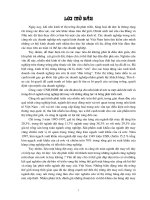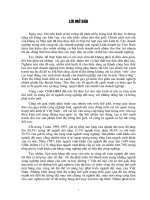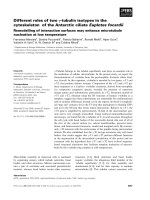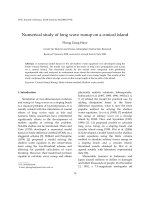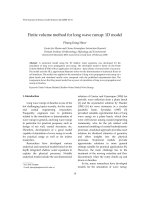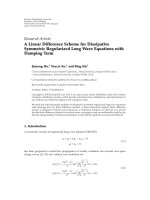Long wave ultra sound may enhance bone remodelling by altering the opg rankl ratio in human osteoblast like cells
Bạn đang xem bản rút gọn của tài liệu. Xem và tải ngay bản đầy đủ của tài liệu tại đây (801.16 KB, 98 trang )
LONG WAVE ULTRASOUND MAY ENHANCE BONE
REMODELLING BY ALTERING THE OPG/RANKL
RATIO IN HUMAN OSTEOBLAST-LIKE CELLS
ABHIRAM MADDI
(BDS, Manipal Academy of Higher Education, India)
A THESIS SUBMITTED
FOR THE DEGREE OF MASTER OF SCIENCE
DEPARTMENT OF ORAL AND MAXILLOFACIAL SURGERY
FACULTY OF DENTISTRY
NATIONAL UNIVERSITY OF SINGAPORE
2005
Supervisor:
A/P Ho Kee Hai
BDS (Singapore)
FDSRCPS (Glasgow)
FAMS (Singapore)
Consultant
Dept. of Oral and Maxillofacial Surgery
National University of Singapore
Co-Supervisors:
Dr Sajeda Meghji
BSc, MPhil, PhD (London)
Reader in Oral Biology
Eastman Dental Institute for Oral Health Care Sciences
University College London
Professor Malcolm Harris
DSc, MD, FDSRCS, FRCS (Edin)
Dept. of Oral and Maxillofacial Surgery
Barts and The London School of Medicine and Dentistry
2
Dedication
I would like to dedicate this thesis to my family, my friends and most
importantly to my mentors whose constant support and motivation made
this work possible
3
Acknowledgements
I would like to thank my supervisor A/P Ho Kee Hai for his constant help,
guidance and enthusiasm throughout my candidature. I am grateful to him and
the Faculty of Dentistry for sponsoring my training at the Eastman Dental
Institute, UCL, London where the in vitro work was done. I warmly acknowledge
Dr Sajeda Meghji, my co-supervisor, under whose guidance I had received
training for molecular research techniques like ELISA and Real Time PCR and
the experience gained is an asset for my future research career. I cannot thank
enough Professor Malcolm Harris also a co-supervisor who has been a constant
motivating factor apart from being a great teacher to me; he has helped me
evolve in my research thinking. I also acknowledge the help and guidance of my
fellow researchers at the Eastman, Dr Ali Reza, Dr Rachel Williams, Dr Lindsay
Sharp, Dr Hesham Khalil and Dr Wendy Heywood for teaching me cell culture
and laboratory techniques. I would also like to thank my colleagues and support
staff at the Dentistry research labs, DSO for their constant help. I would finally
like to acknowledge the National University of Singapore for endowing me with
the NUS Research Scholarship and the President’s Graduate Fellowship and
would like to congratulate it for impartially selecting foreign students and
grooming their talents.
4
Declaration
I hereby declare that this dissertation is original to the best of my knowledge and
does not contain any material, which has been submitted previously for any other
degree or qualification.
Abhiram Maddi
5
Table of Contents
Dedication………………………………………………………………………………..3
Acknowledgements……………………………………………………………………..4
Declaration……………………………………………………………………………… 5
Table of Contents……………………………………………………………………….6
List of Abbreviations…………………………………………………………………....9
List of Symbols…………………………………………………………………………10
List of Figures…………………………………………………………………………..11
List of Tables…………………………………………………………………………...12
Abstract..………………………………………………………………………………. 13
CHAPTER I. Introduction……………………………………………………………15
1. Osteoradionecrosis
1.1 Definition…………………………………………………………….16
1.2 Incidence……………………………………………………………16
1.3 Site of Incidence…………………………………………………...16
1.4 Classification of osteoradionecrosis……………………………..16
1.5 Etiopathogenesis…………………………………………………..17
1.6 Risk Factors………………………………………………………..19
1.7 Time of Development of osteoradionecrosis…………………...19
1.8 Diagnosis of osteoradionecrosis…………………………………19
1.9 Investigation of osteoradionecrosis………………………………20
1.10 Management of ORN…………………………………………….21
6
2. Therapeutic Ultrasound…………………………………………………….24
2.1 Historical…………………………………………………………….25
2.2 Physical Characteristics…………………………………………...27
2.3 Terminology…………………………………………………………28
2.4 Ultrasound Wave Form……………………………………………29
2.5 Ultrasound Transmission through tissues……………………….30
2.6 Absorption and Attenuation……………………………………….32
2.7 Therapeutic Ultrasound and Tissue Healing……………………34
2.8 Effect of Ultrasound on Tissue repair…………………………….37
2.9 The Ultrasound Apparatus………………………………………...39
3. Bone Remodeling and TNFR Superfamily……………………………………42
3.1 Bone Remodelling………………………………………………….42
3.2 RANKL……………………………………………………………....44
3.3 RANK………………………………………………………………..45
3.4 OPG………………………………………………………………….47
3.5 TNF-α………………………………………………………………..48
CHAPTER II. Hypothesis and Aims……………………………………………….49
CHAPTER III. Materials and Methods…………………………………………….50
1 Cell Culture……………………………………………………………50
2 Ultrasound Experiment………………………………………………52
7
3 Reverse Transcriptase Polymerase Chain Reaction (RT-PCR)...55
4 Quantitative Real Time PCR (Q PCR)…………………………......59
5 Immunochemistry…………………………………………………….60
6 Statistical Analysis……………………………………………………61
CHAPTER IV. Results………………………………………………………………62
1. Effect of Ultrasound on osteoprotegerin (OPG) and receptor
activator for NF-қB ligand (RANKL) mRNA and protein
production…………………………………………………………..62
2. Effect of Ultrasound on the mRNA and protein production of
TNF-α in human osteoblast like cells…………………………….67
3. Effect of Ultrasound on the expression of alkaline phosphatase
(ALP) and osteocalcin (OCN) in human osteoblast like cells….68
CHAPTER V. Discussion……………………………………………………………72
8.1 Introduction…………………………………………………………72
8.2 Discussion of Methodology……………………………………….75
8.3 Discussion of Results……………………………………………..77
CHAPTER VI. Conclusion............................................................................... ..79
Bibliography.......................................................................................................80
Paper Publications from this thesis………………………………………………98
8
List of Abbreviations
ALP
Alkaline Phosphatase
DNA
Deoxyribo Nucleic Acid
ELISA
Enzyme Linked Immunosorbant Assay
GAPDH
Glyceraldehyde Phosphate DeHydrogenase
RNA
Ribo Nucleic Acid
mRNA
Messenger RNA
NCP
Non collagenous protein
OB
Osteoblast
OC
Osteoclast
OCN
Osteocalcin
OPG
Osteoprotegerin
ORN
Osteoradionecrosis
PCR
Polymerase Chain Reaction
Q-PCR
Quantitative Polymerase Chain reaction
RANK
Receptor Activator of NF-қB
RANKL
Receptor Activator of NF-қB Ligand
RT-PCR
Reverse Transcriptase Polymerase Chain Reaction
TNF-α
Tumor Necrosis Factor alpha
US
Ultrasound
9
List of Symbols
λ
Wave length
µg
Micrograms
pg
Picograms
n
Frequency
ml
Milli-litre
µl
Micro-litre
V
Velocity
Hz
Hertz
w
Watts
10
List of Figures
Figure 1
Shape of the Ultrasound Beam…………………………………………29
Figure 2
Rarefaction of the Ultrasound Beam…………………………………..32
Figure 3
The Long Wave Ultrasound Machine………………………………….39
Figure 4
The Ultrasound Transducer…………………………………………….40
Figure 5
An Electric Field re-aligns the dipoles in a Piezo-electric crystal…..41
Figure 6
Current understanding of preosteoblastic / stromal cell regulation of
Osteoclastogenesis……………………………………………………..46
Figure 7
US treatment being performed in a sterile air-flow chamber………..52
Figure 8
The administration of US……………………………………………….53
Figure 9
Schematic of the Ultrasound Experiment……………………………..54
Figure 10
Pictures of gel analysis of RT-PCR products of GAPDH and OPG..62
Figure 11 OPG mRNA expression at various time points………………...…......63
Figure 12 OPG protein levels………………………….……………………………64
Figure 13 RANKL protein levels………………….………………………………...66
Figure 14 TNF-α protein levels.…………………………………………………….67
Figure 15
Pictures of gel analysis of RT-PCR products of GAPDH and OCN..68
Figure 16 OCN protein levels……………………………………………………….69
Figure 17 ALP mRNA expression at various time points………...………………70
11
List of Tables
Table 1
Approximate Velocities of Ultrasound through Selected Materials…...31
Table 2
Primer Sequences for RT-PCR…………………………………………..58
Table 3 Summary of Results………………………………………………………..71
12
Abstract
Osteoradionecrosis (ORN) of the mandible has been a formidable long term
complication of radiotherapy, instituted for the treatment of tumors of the head
and neck region. The un-restorable decayed teeth in the mandible in the path of
radiation have to be removed, but whether before or after radiation, such
extractions can still lead to ORN. Its mainstream prophylaxis and treatment is
Hyperbaric oxygen therapy (HBO), which is expensive and not accessible to all
the patients.
Therapeutic Ultrasound (US) has been shown to promote repair in bone fractures
and soft tissue injuries in in vivo studies in rats and humans. In vitro studies have
shown that long wave US treated osteoblasts, fibroblasts and macrophages
increased synthesis of growth factors which play prominent roles in angiogenesis
and healing. The cytokines, TNF-α (tumor necrosis factor alpha), receptor
activator of NF-κB Ligand (RANKL) and osteoprotegerin (OPG) have been
shown to act directly or indirectly on osteogenic cells and their precursors
to control differentiation, resorption and bone formation. RANKL and TNF-α
promote osteoclast differentiation and thus bone resorption whereas OPG
promotes osteoblast differentiation and also competes with RANKL for the
receptor activator of NF-κB (RANK) receptor present on the osteoclast. Human
osteoblast cell line (MG63
cells)
were treated with long
intensity-30mW/cm2) continuous ultrasound (US)
wave
(45 KHz ,
and incubated for various
time periods following the treatment. The reverse transcriptase polymerase
13
chain
reaction
(RT-PCR) technique
was
used
for
observing
genetic
expression and real time PCR for quantitative analysis of the genetic
expression of RANKL and OPG along with alkaline phosphatase (ALP), an
early bone marker and osteocalcin (OCN), a late marker. ELISA was
performed to estimate the amount of the cytokine released into the culture
media, following US treatment. The osteoblasts responded to US by
significantly upregulating both the OPG mRNA and
protein levels. There
was no RANKL mRNA expression observed in both the US and control
groups and the protein levels were also very low in both groups and
significantly low in the US group. There was also no TNF-α expression and
the
TNFα
protein levels
were
insignificant.
ALP and OCN mRNA were
significantly up regulated in the US group.
To my knowledge this is the first study that shows the effect of US on OPG and
RANKL. US appears to up regulate OPG and may down regulate RANKL
production. From these findings, we conclude that therapeutic ultrasound may
increase bone regeneration by altering the OPG/RANKL ratio in the bone
micro-environment.
14
CHAPTER I
INTRODUCTION
1. Osteoradionecrosis (ORN)
Radiotherapy is an essential treatment modality for oral and head and neck
malignant neoplasms. Unfortunately it induces alterations in the normal tissues,
resulting in early and long term complications. Mandibular osteoradionecrosis is
the most common long term complication of radiotherapy with a variable
incidence ranging from 2 to 44.2%. With adequate prevention the incidence is
still around 2-5% (Reher et al.)
Osteoradionecrosis (ORN) of the mandible was for a long time considered as an
osteomyelitis of the irradiated bone resulting from a triad of radiation, trauma and
infection. Marx and Klinge redefined this concept and pointed out that
osteoradionecrosis is not a primary infection of the bone; rather it is induced by a
metabolic and tissue haemostatic deficiency due to radiation induced cellular
injury. In 1983, Marx at the University of Miami described a rational foundation
idea, namely radiation tissue hypoxia, hypovascularity and hypocellularity, tissue
breakdown and chronic non-healing wounds as the main pathogenesis for ORN.
Bras et al., have reported that the radiation induced obliteration of the inferior
alveolar artery is the dominant factor in the onset of osteoradionecrosis leading
to an ischaemic necrosis of bone. Marx et al., also showed that micro-organisms
are not the primary causative factor, but play a role only as contaminants in
osteoradionecrosis.
15
1.1 Definition
Many definitions have been attributed to ORN over the years but a definition
given by Hutchinson in 1996 seems to be the most sensible, which states that
“ORN is an area of exposed bone in the mouth or on the face for more than two
months in a previously irradiated field in the absence of recurrent tumour”.
1.2 Incidence
There is a great variance in the incidence rates of ORN in the literature.
According to the most recent study done by Sulaiman et al, 2003 the incidence of
ORN was 2% among 187 cancer patients who underwent 951 dental extractions
with only 7 patients treated with HBO therapy prophylactically.
1.3 Site of Incidence
The mandible is the most common site of incidence of ORN probably because it
is often necessary to deliver a high dose of radiation to tumors of the tongue and
floor of the mouth and also probably as the blood supply is less abundant as
compared to the maxilla. Furthermore most maxillary tumors are treated
surgically before or after radiotherapy.
1.4 Classification of ORN
Coffin in 1983 examined 2853 patients who received radiotherapy for head and
neck malignancies and suggested that ORN develops in two forms a) Minor and
b) Major. The Minor form is considered to be a series of small sequestra which
16
separate spontaneously after varying periods of time and can be seen clinically
but not radiologically. The Major form occurs when necrosis involves the entire
thickness of the jaw and a pathological fracture is inevitable. This form is very
obvious radiologically.
1.5 Etiopathogenesis
Many theories have been formulated to explain the etiology of ORN since its first
observation in 1920s but the most accepted one originates from the work done
by Marx in 1983.
The Radiation, Trauma and Infection Theory
In 1970 Meyer named the classical triad of ORN as “radiation, trauma and
infection”. He described the role of trauma as a portal of entry for the oral
bacterial flora into the underlying bone.
The
theory
of
non-healing
wound
due
to
Hypoxic-Hypovascular-
Hypocellular tissue
Marx in 1983 examined the traditional concept of the pathophysiology of ORN
described by Meyer questioning the occurrence of ORN without trauma or
infection. He studied 26 cases of ORN from which 12 en bloc resection
specimens were cultured and stained for micro-organisms. The microbiology
reports showed that all specimens were infected superficially but no organisms
could be cultutred from the deep, so called infected bone of ORN. The
17
histological findings observed by Marx showed endothelial death, hyalinization
and thrombosis of vessels with a fibrotic periosteum. Osteoblasts and osteocytes
were deficient with fibrosis of the marrow spaces. The overall result was a
composite tissue, which is hypovascular and hypocellular and was proven to be
hypoxic compared with non-irradiated tissue by direct measurement .
Current Concepts
Bilal et al, have found in a histological study of human specimens with ORN as
well as in specimens subjected to just 36 Gy radiation after a few weeks interval,
a loss of vitality of osteocytes. Marx et al and Rosenberg et al 2003 have
reported a type of osteonecrosis occurring in patients using bisphosphonates,
which bears characteristic resemblance to ORN. These osteonecrosis patients
have
undergone
suppression
of
osteoclasia
with
biphosphonates.
Bisphosphonates could reduce osteoclastic bone resorption through: (a) inhibition
of osteoclast recruitment to the bone surface; (b) inhibition of osteoclast activity
on the bone surface; (c) shortening of the osteoclast life span; and (d) alteration
of the bone or bone mineral in ways which reduce, by a pure physicochemical
and not a cellular mechanism, the rate of its dissolution. The first three effects
could be due to direct action on the osteoclast, or indirectly via the cells which
modulate osteoclast activity. So ORN might be the result of early cellular effects
of radiation.
.
18
1.6 Risk Factors
•
Tumour size and location
•
Radiation dose
•
Local Trauma
•
Dental Extractions
•
Infection
•
Immune defects
•
Malnutrition
Many patients abuse alcohol and tobacco and are in poor general medical
condition, which together with poor nutritional status and lack of oral hygiene may
place them at a higher risk of ORN.
1.7 Time of Development of ORN
The time of development of ORN following radiation can be variable but the
majority of cases occur between 4 months and 2 years. Gowgiel in 1960 noted
that ORN of the mandible develops within 2 years of irradiation. Clayman in 1997
found that the highest risk for ORN was between 4 and 12 months following
irradiation.
1.8 Diagnosis of ORN
The diagnosis of ORN is primarily based on the clinical signs of ulceration of the
mucous membrane with exposure of necrotic bone. The lesion may be
19
accompanied by symptoms of pain, dysesthesia, fetor oris, dysguesia and food
impaction in the area (Braumer et al, 1979; Epstein et al, 1987).
Marx and Johnson (1987) found the following diagnostic signs to correlate with
increased signs of radiation tissue injuries:
•
Induration of tissue
•
Mucosal radiation telangiectasias
•
Loss of facial hair growth
•
Cutaneous atrophy
•
Cutaneous flaking and keratinization
•
Profound xerostomia
•
Profound taste loss
1.9 Investigation of ORN
ORN can be investigated by many techniques but the ideal investigative tool
according to Hutchinson (1996) should be able to offer the following:
1. Record quantitatively and qualitatively the severity and extent
2. Monitor the progress of treatment
3. Predict patients at risk
4. Predict risk factors more confidently
5. Permit comparisons of treatment regimens
6. Predict the level of bone damage above which surgery is essential
20
The following investigations would be useful:
1. Radiography, CT and MRI
2. Nuclear medicine
3. Ultrasonography
4. Transcutaneous and transmucosal oximetry
5. Near Infrared Spectroscopy
1.10 Management of ORN
The aims of the treatment are elimination of pain and associated infections,
achieve vascularisation and mucosal/skin coverage, improvement of mouth
function (opening, speech, mastication) and the elimination of deformity (fistulas,
bone exposures and pathological fractures).
The various treatment options for osteoradionecrosis are as follows –
1. Antibiotics and curettage.
2. Hyperbaric oxygen (HBO) therapy with or without surgery.
3. Debridement and local flaps.
4. Resection and reconstruction.
5. Therapeutic Ultrasound (US) - Most recently described (Harris 1992, Refer et
al, 1997, 1998, Doan et al., 1999)
Dental management of patients who are about to receive therapeutic radiation
involving the jaws, remains a perplexing problem. The unrestorable decayed
21
teeth in the mandible which come in the path of radiation have to removed,
whether before or after radiation and can lead to osteoradionecrosis.
Conservative Management
According to Scully and Epstein (1996), conservative management with
medication and local wound care help in resolving 60% of the cases.
Maintenance of good oral hygiene with the use of 0.02% chlorhexidene mouth
washes after meals and constant saline washes are a must. Debris should be
washed/irrigated and sequestra should be allowed to separate spontaneously or
gently removed, since any surgical interference may encourage extension of the
necrotic process because of the lack of normal bone repair. Though ORN is not
primarily an infectious process, tetracyclines have been recommended because
of their selective uptake by bone (Rankow and Weissman, 1971). Penicillin has
also been used, because of the involvement of oral bacteria in the superficial
contamination (Marx et al 1985). Morton and Simpson, 1986 recommend packs
of BIPP (Bismuth and Iodoform Paraffin paste) for covering small areas of
exposed bone and delicate granulation tissue for keeping necrotic bone cavities
clean.
Hyperbaric Oxygen (HBO) therapy
HBO is administered as 20 sessions of 90 minutes each, breathing 100%
humidified oxygen at 2.4 atmospheres absolute pressure before surgery and 10
sessions after surgery. The empirical use of HBO to promote neovascularity and
22
neocellularity in irradiated and other sclerotic bone conditions has had success,
though usually as an adjunctive preparation to resection and reconstruction.
Marx has confirmed the value of hyperbaric oxygen as an adjunct to promote
neovascularity and neocellularity but recommends radical excision and
reconstructive surgery for 70% of the cases. Both the adjunctive HBO therapy
and surgery are a formidable experience to the patient who has already had
extensive surgery and other therapies for the malignant neoplasm. The major
disadvantages of HBO are that it is time consuming and expensive and most of
the previous studies done to prove its efficacy are uncontrolled.
Also HBO
therapy is hazardous in patients with chronic emphysematous lung disease
which is not uncommonly associated with oral cancer.
According to Clayman it costs 1.5 million dollars to treat 100 patients with HBO.
In Singapore the cost of HBO therapy per person for 30 sessions is 7800 Sing $
at the rate of 260 S$ per session (Tan Tok Seng Hospital). A multicentre
randomized, placebo-controlled, double blind trial done by Annane et al showed
that the patients treated with HBO not only failed to benefit from the treatment but
also they had an unfavourable outcome as compared to the patients treated with
placebo. Similarly Cawood et al have recently shown in 329 patients that HBO
did not improve the integration outcome of titanium implants in irradiated jaws
(unpublished). Coulthard et al, in their review on the therapeutic use of HBO for
irradiated dental implant patients, have clearly mentioned that there is no
23
substantial evidence for the use of HBO and that more randomized controlled
trials are required to determine its effectiveness.
Ultrasound (US) Therapy
It is obvious that HBO could not cure many cases of ORN and moreover it is too
expensive to use it as a prophylactic measure in oral cancer patients receiving
radiotherapy. The cost of HBO for a single patient is enough for buying at least 5
US machines which are readily available, economic and easy to apply. US has
been proven to enhance bone formation, angiogenesis and synthesis of growth
factors and cytokines which are essential to bone metabolism.
Surgery
Surgery is very often a treatment option for ORN. Surgical options start with the
removal of small sequestra and increase depending on the case to
sequestrectomy, alveolectomy with primary closure, closure of oro-cutaneous
fistulae and flaps to cover the area. In extreme cases large resections and hemimandibulectomies are performed and the bone should be reconstructed
preferably with a bone source with its own blood supply, like fibula or iliac crest
vascularized flaps.
2. Therapeutic Ultrasound
Disturbed bone healing may occur as a side-effect of various therapies like
osteotomies, bone grafting, distraction osteogenesis and radiation therapy. Over
the years various interventions have been used to stimulate the healing process
24
and among them ultrasound remains distinguished by being non-invasive and
easy to apply. Ultrasound has been traditionally used in the field of physiotherapy
to treat soft tissue disorders by deep heating the tissues using intensities of 0.5
to 3 watts/cm². The intensities used for bone healing are considerably lower than
those used in physiotherapy because of the risk of over-heating the bone.
2.1 Historical
It was in 1880 when Jacques and Pierre Curie first observed that certain crystals
generated electricity when distorted. This observed effect which was called the
piezo-electric effect when reversed resulted in the emission of a high frequency
sound wave which we call the ultrasonic wave or precisely as ultrasound. The
crystals when subjected to an alternating current, expand and contract resulting
in the production of ultrasound. Paul Langevin (France, 1926), during the First
World War, used this effect in the detection of submarines. He was also the first
to observe the biological effects of ultrasound; fish introduced into a tank with
strong ultrasound field died after a period of violent motions and investigators
experienced pain of considerable severity when they thrust their hands into the
tank.
Pohlman in Germany,1938, was the first to construct an ultrasound device to
treat patients and found that patients with lower back pain, myalgias and
neuralgias responded favorably to treatment of the affected areas for 5 to 10
minutes daily for 10 days using a frequency of 800 kHz and an intensity of 4 to 5
25
